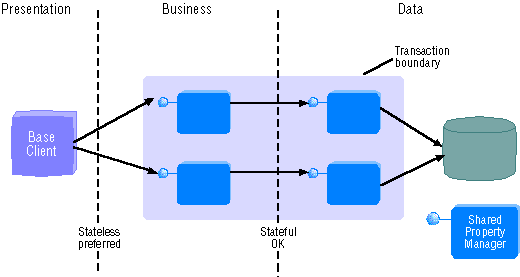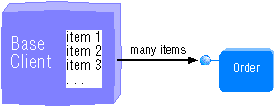
| Platform SDK: Transaction Server |
[This product will work only on Windows NT 4.0 versions and earlier. For Windows 2000 and later, see COM+ (Component Services).]
Although there are many benefits to using stateless MTS objects, there are cases where holding state is desirable. This topic provides some guidelines in deciding where state is held in your application.
The following diagram shows a three-tier architecture:

Typically, the latency between tiers differs greatly. Calls between the presentation tier and business tier are often an order of magnitude slower than calls between the business tier and data tier. As a result, held state is more costly when calling into the business tier.
However, it often makes sense to hold state within the transaction boundary itself. For example, the objects in the data tier may represent a complex join across many tables in separate databases. Reconstructing the data object state is potentially more inefficient than the cost of the resources held by those objects while they remain active.
Since objects lose state on transaction boundaries, if you need to hold state across transactions, use the Shared Property Manager or store the state in a database.
There are two separate issues when considering the effects of holding state in an application:
Consider the example of an online shopping application. The client chooses items from a catalog and submits an order. Order processing is handled by a business object, which in turn stores the order in a database (not shown).
One way of building the application is for the client to call an Order object, with each call adding or removing an item from the order:

This application has the following properties:
You can require that the client cache the items in an array or recordset:

This application has the following properties:
In addition to network bandwidth and resources, concurrency affects application performance. There are two types of concurrency:
Implementing a server cache implies optimistic concurrency. The server does not have to hold locks on the database, thus freeing resources.
However, if there is high contention for the resource, pessimistic concurrency may be preferred. It is easier to reject a request to access a database and have the server try again than it is to reconcile cached, out-of-date data with a rapidly changing database.